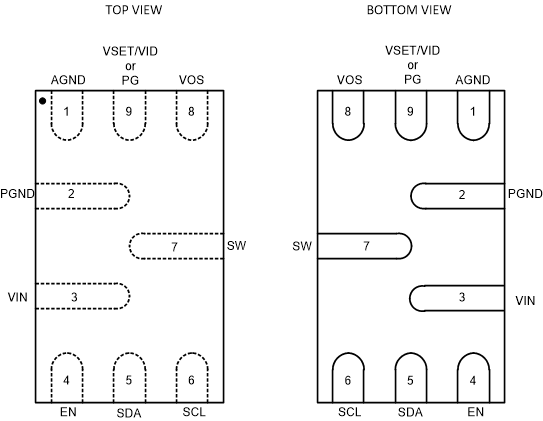JAJSJC9B September 2020 – July 2021 TPS62868 , TPS62869
PRODUCTION DATA
- 1 特長
- 2 アプリケーション
- 3 概要
- 4 Revision History
- 5 Device Options
- 6 Pin Configuration and Functions
- 7 Specifications
- 8 Detailed Description
- 9 Application and Implementation
- 10Power Supply Recommendations
- 11Layout
- 12Device and Documentation Support
- 13Mechanical, Packaging, and Orderable Information
6 Pin Configuration and Functions
 Figure 6-1 9-Pin RQY QFN Package (Top
View)
Figure 6-1 9-Pin RQY QFN Package (Top
View)Table 6-1 Pin Functions
| PIN | DESCRIPTION | |
|---|---|---|
| NAME | NO. | |
| AGND | 1 | Analog ground pin |
| VSET/VID | 9 | Start-up output voltage and device address selection pin. An
external resistor must be connected. After start-up, the pin can be used to select the VOUT registers for the output voltage (Low = VOUT register 1; high = VOUT register 2). See Section 8.4.4. This pin is pulled to GND when the device is in shutdown. The function after start-up depends on the device option. See the Device Options. |
| PG | 9 | Power-good open-drain output pin. The pullup resistor can be
connected to voltages up to 5.5 V. If unused, leave it floating.
This pin is pulled to GND when the device is in shutdown. The function after start-up depends on the device option. See Section 5. |
| VOS | 8 | Output voltage sense pin. This pin must be directly connected to the output capacitor. |
| PGND | 2 | Power ground pin |
| SW | 7 | Switch pin of the power stage |
| VIN | 3 | Power supply input voltage pin |
| EN | 4 | Device enable pin. To enable the device, this pin needs to be pulled high. Pulling this pin low disables the device. Do not leave floating. |
| SDA | 5 | I2C serial data pin. Do not leave it floating. Connect it to AGND if not used. |
| SCL | 6 | I2C serial clock pin. Do not leave it floating. Connect it to AGND if not used. |